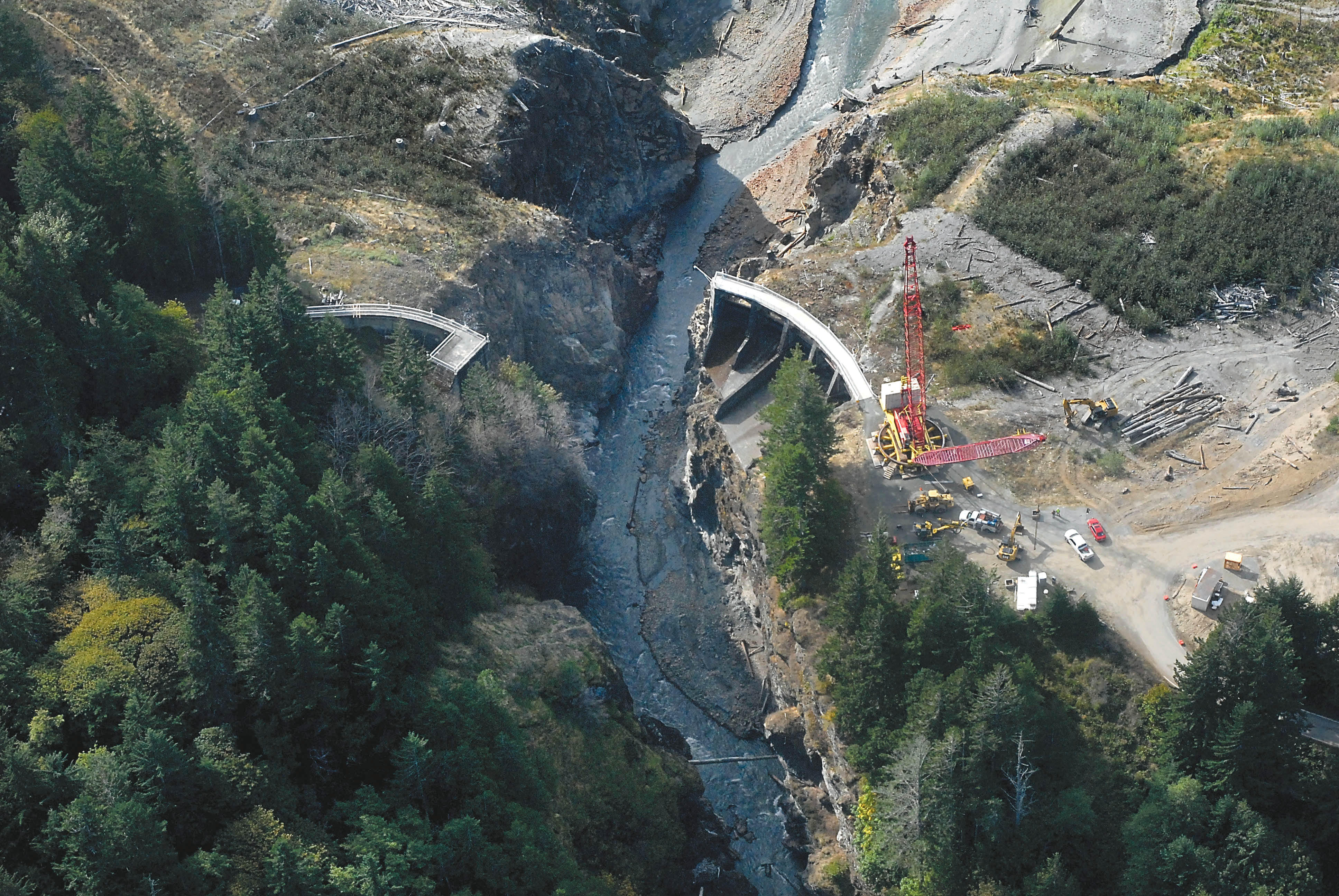OLYMPIC NATIONAL PARK — The National Park Service plans to transform the site of the former Glines Canyon Dam into a destination where the public can learn about the ongoing efforts to restore the Elwha River.
“We know that visitors are eager to revisit the dam site and have access to that area, so we’ll be working to provide access to the overlooks as quickly as possible,” Rainey McKenna, Olympic National Park spokeswoman, said.
The removal of Glines Canyon Dam was completed with a final blast Aug. 26, but the abutments on either side of the once-210-foot-tall structure were left in place to eventually serve as observation points.
“The park is going to be going in and making new parking areas for visitors, and we’ll need to install some privies,” McKenna said.
“Because the two abutments will be open, guardrails where people can stop and look will be put in.”
McKenna also said interpretive signs detailing the larger Elwha River restoration project will be placed predominantly around the west side’s abutment, which will be accessed by Olympic Hot Springs Road.
Short trails will provide access to the dam site and the former Lake Mills, which had been formed by the dam.
The east-side observation point, accessed via Whiskey Bend Road, also will be served by a new parking area.
McKenna estimated that work on the observation areas would start this fall after crews with Barnard Construction Inc. of Bozeman, Mont., finish removing their equipment.
Since there is less work to undertake on the smaller east-side site, McKenna said that area could open to the public as soon as this winter, while the larger west-side observation area is expected to open in 2015, likely around Memorial Day.
“We’re looking to have both sides of the dam open to the public by our next summer season,” she said.
Following the August blast to demolish the final 30 feet of the dam, Barnard workers spent the next several weeks clearing debris from the river channel, finishing that work the week of Sept. 22.
“[Crews] have begun the process of demobilizing from the site,” McKenna said.
Olympic Hot Springs Road remains closed to all access just above Olympic National Park’s Altair Campground and is expected to reopen when work at the west-side observation area is finished.
Whiskey Bend Road remains open to public access.
The $325 million project to remove Glines Canyon Dam and Elwha Dam downstream — together forming the largest dam removal and river restoration ever attempted in the U.S. — began in September 2011.
The last remnants of the 108-foot Elwha Dam were removed in March 2012.
That dam was built in 1913 and was situated 5 miles south of the river mouth, blocking salmon runs from 65 of the nearly 70 miles of river and tributaries.
The Glines dam was built in 1927 about 13 miles south of the river mouth, just inside of Olympic National Park boundaries.
With some 70 miles of river habitat — including tributaries to the 40-mile river — now open for salmon and other species, scientists monitoring the river restoration project are already seeing promising signs of fish recolonizing the waterway.
“We have observed a chinook salmon redd above the dam site, so we have the first naturally migrating chinook spawning above the dam,” McKenna said, adding that two other redds, or spawning nests, were spotted, but what species constructed them was unclear.
“The removal of the dam just happened to coincide with the time we get the chinook run, so we got the chance to see what would happen immediately.”
Monitoring the return of fish to the upper reaches of the river is part of ongoing scientific work by the U.S. Geological Survey, the National Oceanic and Atmospheric Administration, the Lower Elwha Klallam tribe, the National Park Service and the Bureau of Reclamation to document conditions in the Elwha prior to and after the removal of the Glines and Elwha dams.
Ninety-seven fish have been tagged to help record their migration upstream, and McKenna said that as of the most recent information available Sept. 25, five bull trout and at least four chinook have been observed above the former Glines dam by using radio tags and conducting snorkel surveys.
Farther downstream but still above the former Elwha Dam site, McKenna said 10 chinook, 14 bull trout, two steelhead and one sockeye salmon have naturally migrated upstream.
“This is a very good sign, that the fish are moving past the dam sites and moving past the areas that were formerly blocked,” she said.
Fishing of any kind on the river remains prohibited under a five-year moratorium imposed in 2011 to allow its fisheries to recover from the release of sediment introduced by the dam removal.
McKenna said 24 million cubic yards of sediment had built up behind the dams over the years.
Not all of that has been released back into the river, she added.
Another ongoing aspect of the river restoration is the introduction of native and beneficial plant life to the former lakebeds, work that is expected to continue through 2016.
“As we move into this winter, there’s going to be seeding and planting at the reservoirs, primarily at Lake Mills,” McKenna said, adding that planting work at the former Lake Aldwell above Elwha Dam is nearly complete.
She said more than 175,000 plants and 5,800 pounds of seed have been placed in the two reservoir beds to date.
Including the upcoming planting season from this month through March, the park plans to plant another 200,000 to 250,000 native saplings and 2,000 pounds of seeds over the next four years.
“It’s a very exciting time in the Elwha, and there’s a lot more to come,” McKenna said.
“This is not the end; this is just the beginning.”
________
News Editor Michael J. Foster can be reached at 360-452-2345, ext. 5064, or at mfoster@peninsuladailynews.com.
